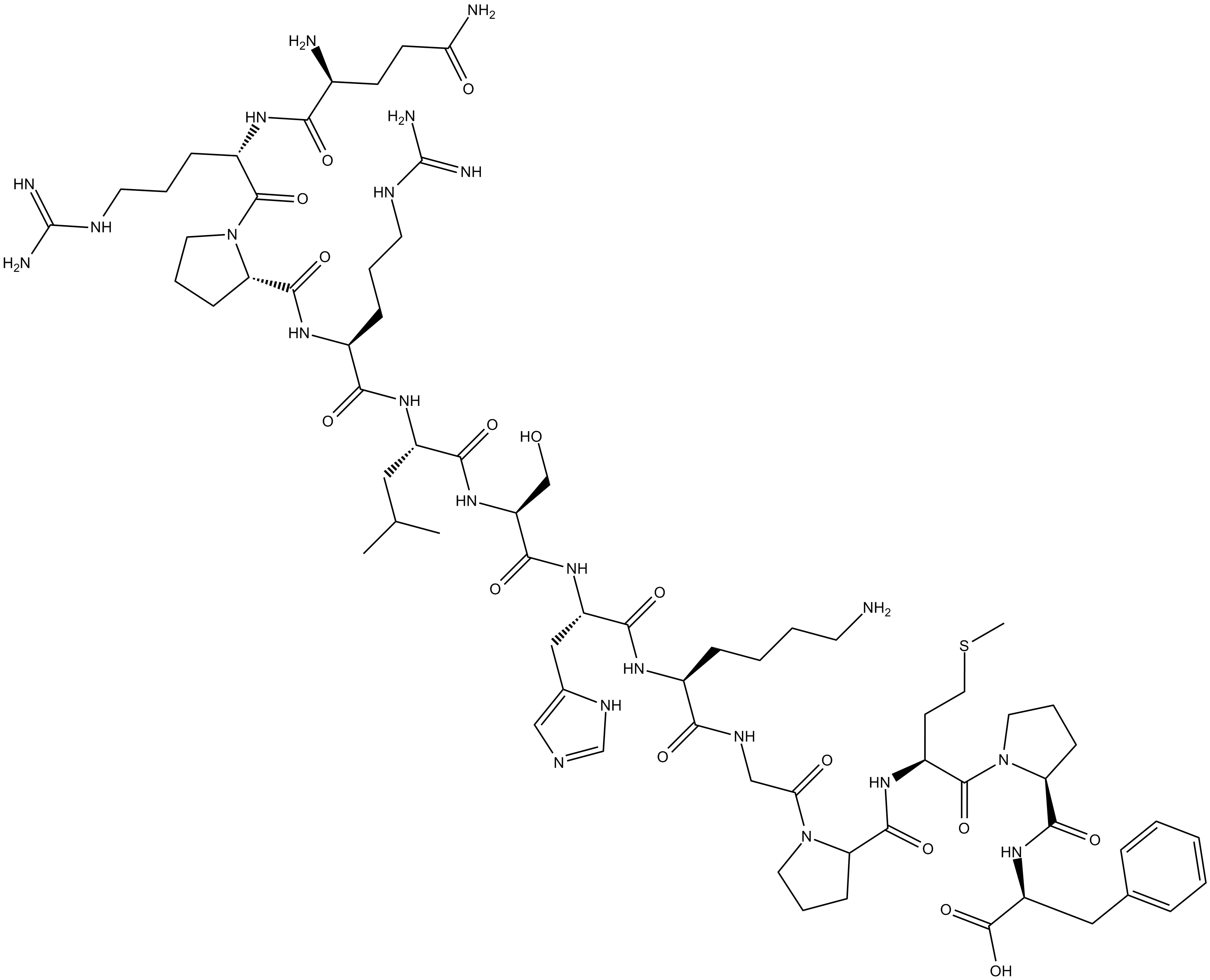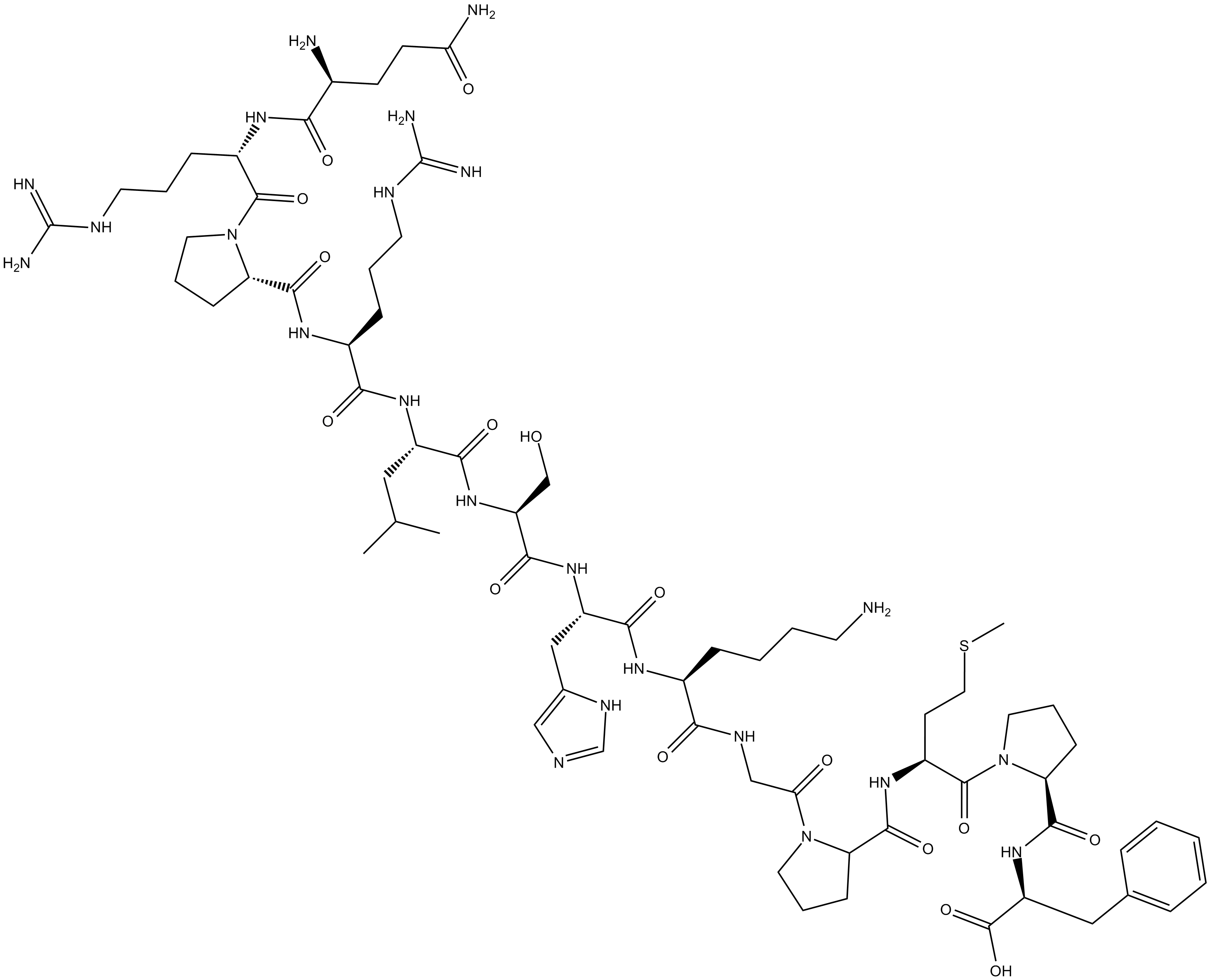Apelin-13
IC50: 0.37 nM for GPCR
Apelin-13 is an endogenous ligand of the APJ receptor.
The apelin receptor APJ, one of a group of G-proteincoupled receptors (GPCR), have recently been paired with their cognate peptide ligands using ‘‘reverse pharmacology’’, and functional evidence suggests a role for this receptor in the regulation of cardiovascular function, fluid homeostasis, and as a coreceptor for HIV infection.
In vitro: Apelin-13 was identified as an endogenous ligand of the APJ receptor, which could activate this G protein-coupled receptor with an EC50 value of 0.37 nM. In addition, the EC50 values for apelin-17 and apelin-36 have been found to be 2.5 and 20 nM, respectively [1].
In vivo: In a previous study, urethane anaesthetised, paralysed and ventilated male SD rats were used to investigate the action of apelin-13 directly microinjected into the nucleus tractus solitarius (NTS) and the rostral ventrolateral medulla (RVLM) on arterial pressure and phrenic nerve activity. Results showed that Apelin-13 microinjections into the NTS led to either apnea or decreased phrenic nerve discharge amplitude by up to 30%. In the RVLM, apelin-13 caused increase in phrenic nerve discharge amplitude depending on the exact site of injection [2].
Clinical trial: Previous clinical study showed that intrabrachial infusions of (Pyr1)apelin-13, acetylcholine, and sodium nitroprusside could cause forearm vasodilatation in patients and control subjects. Systemic infusions of (Pyr1)apelin-13 was able to increase cardiac index and lower mean arterial pressure and peripheral vascular resistance in patients and healthy control subjects but increased heart rate only in control subjects [3].
References:
[1] Lee, D. K.,Cheng, R.,Nguyen, T., et al. Characterization of apelin, the ligand for the APJ receptor. Journal of Neurochemistry 74, 34-41 (2000).
[2] Seyedabadi M, Goodchild AK, Pilowsky PM. Site-specific effects of apelin-13 in the rat medulla oblongata on arterial pressure and respiration. Auton Neurosci. 2002 Oct 31;101(1-2):32-8.
[3] A G Japp, N L Cruden, G Barnes, N van Gemeren, J Mathews, J Adamson, N R Johnston, M A Denvir, I L Megson, A D Flapan, D E Newby. Acute cardiovascular effects of apelin in humans: potential role in patients with chronic heart failure. Circulation 2010 April 27, 121 (16): 1818-27.
| Storage | Store at -20°C |
| M.Wt | 1550.8 |
| Cas No. | 217082-58-1 |
| Formula | C69H111N23O16S |
| Solubility | ≥155.1 mg/mL in DMSO; ≥14.67 mg/mL in EtOH; ≥29.4 mg/mL in H2O |
| Chemical Name | L-glutaminyl-L-arginyl-L-prolyl-L-arginyl-L-leucyl-L-seryl-L-histidyl-L-lysylglycyl-L-prolyl-L-methionyl-L-prolyl-L-phenylalanine |
| SDF | Download SDF |
| Canonical SMILES | O=C([C@H](CCSC)NC(C1N(C(CNC([C@H](CCCCN)NC([C@@H](NC([C@H](CO)NC([C@H](CC(C)C)NC([C@H](CCCNC(N)=N)NC([C@H]2N(C([C@@H](NC([C@@H](N)CCC(N)=O)=O)CCCNC(N)=N)=O)CCC2)=O)=O)=O)=O)CC3=CN=CN3)=O)=O)=O)CCC1)=O)N4[C@H](C(N[C@H](C(O)=O)CC5=CC=CC=C5)=O)CCC4 |
| Shipping Condition | Small Molecules with Blue Ice, Modified Nucleotides with Dry Ice. |
| General tips | We do not recommend long-term storage for the solution, please use it up soon. |
| Cell experiment [1]: | |
|
Cell lines |
Vascular smooth muscle cells (VSMCs) |
|
Preparation method |
Soluble in DMSO. General tips for obtaining a higher concentration: Please warm the tube at 37 ℃ for 10 minutes and/or shake it in the ultrasonic bath for a while. Stock solution can be stored below -20℃ for several months. |
|
Reacting condition |
24 h |
|
Applications |
Apelin-13 promoted VSMC proliferation via inducing phosphoinositide 3 kinase (PI3K)/Akt signaling transduction pathway. Apelin-13 (0.5-4 μM) promoted the expression of phospho-PI3K and phospho-Akt in dose- and time-dependent manner. Apelin-13 promoted VSMC proliferation through PI3K/Akt signaling transduction pathway. |
| Animal experiment [2-4]: | |
|
Animal models |
Wistar rat, Rodent (mouse and rat) models of myocardial I/R injury |
|
Dosage form |
Intracerebroventricular (ICV) administration, intravenous (IV) injection of 10 nmol |
|
Application |
In rats, Apelin-13 had little effect on food intake, but dose-dependently increased drinking behaviour and water intake at 1 h. Apelin-13 (10 nmol) increased water intake. Apelin-13 (10 nmol) significantly increased plasma ACTH and corticosterone and decreased plasma prolactin, LH and FSH at 30 min. In rodent (mouse and rat) models of myocardial I/R injury, apelin-13 reduced infarct size by 43.1% and 32.7%. Intracerebroventricular (ICV) injection of 1 and 3 nmol of apelin-13 resulted in a reduction in food intake in both fed and fasted rats. |
|
Other notes |
Please test the solubility of all compounds indoor, and the actual solubility may slightly differ with the theoretical value. This is caused by an experimental system error and it is normal. |
|
References: [1]. Liu C, Su T, Li F, et al. PI3K/Akt signaling transduction pathway is involved in rat vascular smooth muscle cell proliferation induced by apelin-13[J]. Acta Biochim Biophys Sin, 2010, 42(6): 396-402. [2].Taheri S, Murphy K, Cohen M, et al. The effects of centrally administered apelin-13 on food intake, water intake and pituitary hormone release in rats[J]. Biochemical and biophysical research communications, 2002, 291(5): 1208-1212. [3].Simpkin J C, Yellon D M, Davidson S M, et al. Apelin-13 and apelin-36 exhibit direct cardioprotective activity against ischemiareperfusion injury[J]. Basic research in cardiology, 2007, 102(6): 518. [4]. Sunter D, Hewson A K, Dickson S L. Intracerebroventricular injection of apelin-13 reduces food intake in the rat[J]. Neuroscience letters, 2003, 353(1): 1-4. |
|
Quality Control & MSDS
- View current batch:
Chemical structure









